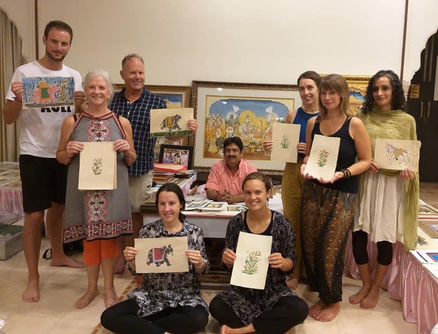Since 1996
Welcome to Rangreet Studio
My name is Ramu Ramdev, son of Shri Achleshwar Prasad Ramdev. My journey in the world of art began under the guidance of my elder brother, Shri Govind Ramdev, and Shri Bannu ji. I specialized in Traditional Style Painting and have dedicated my life to perfecting and preserving this art form. I received the State Award in 1998-99 for excellence in Miniature Painting and the prestigious National Award in 2010.
About Rangreet
As the Rangreet School of Traditional Indian Art enters its 26th year, I reflect on over 48 years of cultural focus and artistry. From a humble beginning in the early 1970s, when the dream of a studio merely existed in my mind, to decades later having established the Rangreet School in 1996, I have dedicated my life to the craft. The mission of Rangreet is clear:
-
To contribute to the preservation of the dying craft of Indian Miniature Art.
-
To create a sustainable Art school for thousands of new and young artists and art lovers for the long term.
Through Rangreet, we place importance directly on teaching art culture in depth and extensively transferring my lifetime of artistry into the hands of those who will carry the traditions forward.
The idea of preserving this dying miniature art was woven into the fabric of my thoughts when I established the Rangreet Organization in 1996 with the aim to teach thousands of young artists and art lovers. The objective was to impart the depth of culture and lifetimes of skill that goes into the working of this art. We encouraged new talents with the blessings of great artists like Ram Gopal Vijayvargiya Ji, Krapal Singh Ji, Dwarka Prasad Ji, and many other renowned artists.
Since then, we have not only demonstrated this traditional art in Jaipur and Jodhpur but have also been invited by several renowned institutions like the Art Institute of Chicago, Oxford University, Detroit Institute of Art, USA, and the Indianapolis Museum of Art. We conducted workshops in America and London for ten consecutive years. This was one of the greatest opportunities of a lifetime to spread awareness of Indian Traditional Art.
In 1997, my brothers and I started organizing workshops at the Maharaja Sawai Man Singh II Museum to connect people to the roots of Indian Art. The credit goes to my brothers and my family members who have been instrumental in the upliftment of this dying art.
During the COVID-19 lockdown, we seized the opportunity to initiate a free online course for 15 days, which saw more than 180 students from Gujarat, Delhi, Mumbai, Himachal Pradesh, Mysore, Pakistan, USA, Canada, Dubai, Jakarta, and London actively participating. The students worked on subjects from the Basohli School of Painting and expressed their love for Indian Traditional Art in a very short span of time.
Today, we have students from all corners of the world. Some have taken the opportunity to pursue a deeper understanding and production of Indian Miniature Art. Others have come to broaden their exposure to a historic style. Many have come to learn our teaching methods, supplementing their educational journey by utilizing our structure to teach and earn a livelihood independently while helping keep traditional Indian Art alive.
Rangreet in the USA and UK
Since its inception, we have demonstrated lessons from the Rangreet School of Traditional Indian Art in Jaipur, Jodhpur, and upon invitation at several renowned institutions such as:
-
Art Institute of Chicago - Alsdorf Galleries – Chicago, USA
-
Oxford University – United Kingdom
-
Detroit Institute of Art – Detroit, USA
-
Indianapolis Institute of Art – Indiana, USA
We have also contributed to the research and historic preservation of Indian Miniature Art through many renowned institutions and publications, such as:
-
Punjabi University – Journal titled “Intensive Understanding of the Arts of Chamba and Jaipur”
-
The Bhavan Centre UK, Institute of Indian Art and Culture
-
Art Institute of Chicago
-
The British Museum
My vision for Rangreet extends beyond teaching; it is about creating a global community of artists who are passionate about Indian miniature art. I am grateful for the support of my family and the dedication of our students. Together, we have given this traditional art form a platform, ensuring its survival and growth for future generations.





















